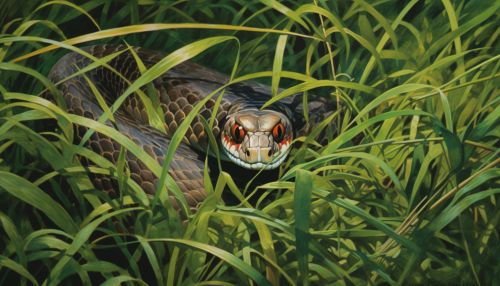Snake Behavior
Introduction
Snakes are a group of reptiles belonging to the suborder Serpentes. They are known for their elongated bodies and lack of limbs. Snakes are found in a variety of habitats across the globe, with over 3,000 species recognized. This article delves into the behavior of these fascinating creatures, focusing on their hunting techniques, mating habits, hibernation, and more.


Hunting and Feeding Behavior
Snakes are carnivorous, feeding on a variety of prey including insects, rodents, birds, and other small animals. The hunting and feeding behavior of snakes varies greatly among species, largely influenced by their anatomy and the environment in which they live.
Prey Detection
Snakes employ a range of techniques to detect their prey. Many species use their forked tongues to pick up scent particles in the air, which are then processed by the Jacobson's organ, a specialized sensory structure located in the roof of the mouth. This organ allows snakes to 'taste' the air, helping them locate their prey.
Hunting Techniques
Snakes employ various hunting techniques, ranging from active hunting to ambush predation. Active hunters, such as the Black Mamba, move around their environment in search of prey. Ambush predators, like the Gaboon Viper, lie in wait for their prey, striking when the prey is within reach.
Feeding
Once a snake has captured its prey, it employs a unique feeding mechanism. Unlike many other animals, snakes do not chew their food. Instead, they swallow their prey whole. To facilitate this, snakes have highly flexible jaws that can dislocate to accommodate large prey.
Mating and Reproduction
The mating habits of snakes are as varied as the species themselves. However, there are some common behaviors observed across different species.
Courtship
In many snake species, males engage in courtship rituals to attract females. These rituals can include tactile and chemical cues. For instance, male garter snakes (Thamnophis) engage in a 'mating ball,' where multiple males wrap around a single female in an attempt to mate.
Reproduction
Snakes can reproduce either through oviparity (laying eggs) or viviparity (giving live birth). Oviparous snakes, like the Corn Snake, lay eggs that incubate outside the body. Viviparous snakes, such as the Boa Constrictor, give birth to live young.
Hibernation
In colder climates, many snake species undergo a period of dormancy known as hibernation. During this time, snakes retreat to a safe location, such as a burrow or rock crevice, and remain inactive until temperatures rise. This behavior, known as brumation, is similar to hibernation in mammals but differs in that snakes do not eat, drink, or defecate during this period.
Defense Mechanisms
Snakes employ a variety of defense mechanisms to protect themselves from predators. These can include hissing, puffing up their bodies to appear larger, and in some cases, playing dead. Some snakes, like the Cobra, can even spit venom as a defensive tactic.
Conclusion
Understanding snake behavior is crucial for both conservation efforts and human-snake interactions. Despite their often-maligned reputation, snakes play a vital role in their ecosystems as both predators and prey. Further research into their behavior can help us appreciate these fascinating creatures and their place in the natural world.
